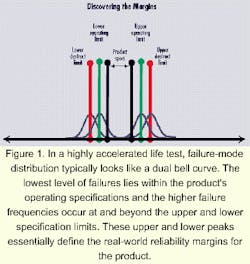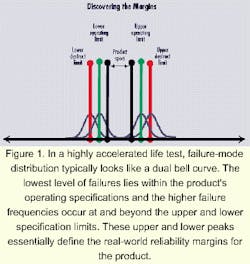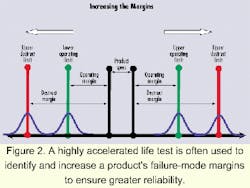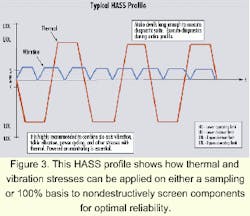Lifecycle and stress tests promise FIT-rate products
HALT and HASS techniques can improve reliability and streamline development cycles.
Simon Prakash
Cielo Communications Inc.
The global networking environment is undergoing a dramatic shift toward the use of fiber-optic technologies. As escalating traffic, performance, and reliability demands drive the deployment of fiber-optic solutions, the reliability of a network's optoelectric devices is a critical underlying factor for maintaining acceptable service levels. At the same time, the push to rapidly improve network performance is requiring shorter product-development cycles and the ability to quickly ramp up volume production for optoelectric devices.
Two tests can facilitate this process. The highly accelerated life test (HALT) can be used to quickly identify and resolve potential failure modes in optoelectric devices throughout the product-development cycle. The highly accelerated stress screening (HASS) can help to ensure optimal production reliability.
The reliability of computing and communications systems has traditionally been expressed in terms of mean time to failure (MTTF), which is measured in hours and is dependent upon the equipment's duty cycle. For today's critical communications environments in which equipment must meet stringent demands for continuous uptime, reliability is often measured in terms of failures in time (FITs) for billions of hours. To comprehensively manage overall reliability factors and account for the potential cumulative impacts of failure rates at the component level, specified FIT-rate requirements can be established for various levels of a communications system. For example, for optical-switching equipment, FIT-rate requirements under Telcordia Technologies (formerly Bellcore) standards are specified in the range of 8,250 FITs at the system level, 825 FITs at the module level, and no more than 400 FITs for individual laser components.In order to meet these stringent FIT-rate requirements at the component level, it is imperative that manufacturers of optoelectric devices incorporate some form of proactive life testing into their reliability programs. In general, life testing methodologies can be used to determine the MTTF/FIT rate for a device by accelerating time through the application of higher than normal operating stresses.
As the name implies, a HALT program is designed to significantly accelerate the life testing process through the controlled application of multiple stress factors, such as temperature, vibration, voltage margining, and power cycling. Because HALT acceleration techniques can compress the life testing process into just a matter of days, it can effectively be used as an integral part of the product-development process to proactively precipitate and detect design and/or manufacturing problems. Instead of having to wait thousands or even tens of thousands of hours for life testing results, a HALT can provide timely feedback to research and development staff during the ongoing development process, enabling identification and correction of critical design issues.
HALT techniques focus on incrementally stepping the devices well beyond specified parameters in order to explore available operating margins and to expose actual failure-mode distributions. For example, with a stress factor such as temperature, the products undergo continuous functional testing while in the chamber as the temperature level is stepped through a series of controlled increases, such as 10°C increments. Then as errors begin to occur, a root-cause analysis is conducted to determine the reasons for the failures and to address these weaknesses via design and/or process improvements.
Another benefit of HALT techniques is the use of quasi-random vibration to subject the products to a wider range of frequencies, compared to traditional sinusoidal testing methods. Rather than ramping up to designated stress levels via a predictable sine wave that may inadvertently mask some failures, HALT applies multiple frequencies using a variety of sequences and ramp times.Basically, every failure mode has a unique distribution that looks like a dual bell curve, in which the lowest level of failure lies within the products' operating specifications and higher failure frequencies generally occur at and beyond the upper and lower specification limits (see Figure 1). Because these upper and lower peaks in failure modes essentially define the real-world reliability margins for the product, the key objectives of HALT are to discover the margins for each failure mode and then to increase those margins for greater reliability (see Figure 2).
It is important to note that the HALT process is not intended to simulate actual field environments but rather to impose higher stress levels under controlled conditions to expose the weak links in product design and manufacturing processes. By identifying and fixing even those failures that occur beyond normal operating limits, the HALT process consistently extends the product's fundamental range of flawless operation as well as pushes out the product's destruct limits. Ultimately, the goal of a HALT program is to push the margins for all failure modes far enough out so that they do not impinge upon the specified operating range under any conditions.
In a HALT process, every stimulus that can affect the product is of potential value for precipitating failures. These may include all-axis impact vibration, broad-range thermal cycling, thermal shock, burn-in, over-voltage, and voltage cycling. The ability to individually control each stress factor is important in order to aid in isolation of root causes for failures and to develop corrective actions. However, it is also important to simultaneously combine stress factors, such as applying vibration impacts within an elevated temperature chamber, to expose those failures and design defects that only occur under multiple stress factors. By using a wide range of multiple stresses, both individually and in combination with each other, a well-designed HALT program is able to mimic the full breadth of random real-world stresses while also amplifying their overall magnitude well beyond real-world conditions.For maximum benefit, HALTs should be performed from early prototype through limited production availability or until both the software code and the hardware are stable. In addition, the test should be used whenever a subsequent change affects the functionality, reliability, or quality of the product. Rather than a single point-in-time event, a HALT can be most effective when treated as a comprehensive cradle-to-grave reliability management technique that comes into play at key junctures throughout the product lifecycle.
A well-designed HALT program is particularly useful for optimizing the reliability of complex optoelectric devices throughout the development process. Using a "building-block" approach, targeted HALT techniques can be independently applied to assess reliability characteristics for various aspects of the product as it is developed, without necessarily having to wait until the full product is assembled.
For example, a vertically integrated research and development organization can cost-effectively use HALT techniques to test and refine the designs for laser drivers and/or receiver electronics without needing to assemble the entire device. Or alternatively, because vertical-cavity surface-emitting lasers (VCSELs) can be functionally tested while still in a wafer state, HALT techniques can be effectively used to target and improve reliability results for VCSEL manufacturing, independent of any of the subsequent processes used for final device assembly.
Not only does the incremental application of HALT allow multiple aspects of the design program to proceed in parallel, it also enables the HALT process to accurately expose failure modes that are specific to a subcomponent design or assembly process. This ability to use the HALT process on limited areas of the product design is often beneficial in quickly identifying specific root causes and making design corrections without having to conduct hit-and-miss analysis among multiple potential causal factors.
Within real-world product-development processes, HALT techniques have already shown significant benefits in the following key areas:
- Empirically assessing the reliability tradeoffs between multiple vendor-supplied components to aid in the selection of optimal supplier sources.
- Modeling and analyzing design-for-manufacture alternatives, such as evaluating the solderability results and reliability implications of using different circuitry layouts.
- Optimizing process techniques, such as using HALT to evaluate the reliability of different process parameters for the alignment and bonding of laser components.
The incremental building-block nature of HALT also lends itself well to the targeted review of design changes and improvements to product designs after they have been released to manufacturing. Rather than waiting for complete integration of the design changes and full life testing on the new product revisions, HALT can be used early in the redesign process to target stress factors directly onto the proposed changes and thereby expose any latent reliability problems.
HASS is a targeted technique for optimizing ongoing product reliability by applying controlled stress to production-level products to precipitate latent defects. In contrast to HALT, which is focused on identifying and resolving product design defects, HASS is focused on verifying and improving manufacturing defects. HASS is performed from early production build through product maturity in order to monitor the quality and consistency of a production process as well as the quality of contributing suppliers' processes.
Building upon the prior HALT testing process, HASS is designed for production control of a specific product or product family. By using the data developed during HALT, a highly effective HASS profile can be created to stress production-level components beyond their specifications but within the extended HALT operating limits (see Figure 3).
Unlike traditional ongoing reliability testing, which subjects a sample of production components to extended and often destructive stress testing, HASS profiles are tailored to proactively expose failures in a rigorous but nondestructive fashion. Like HALT processes, HASS is specifically designed to generate root-cause data from the failure-analysis process, which can then be used to drive immediate corrective actions to improve upstream production processes.
The combination of HALT and HASS methodologies can provide critical advantages, especially when deployed within a company's overall reliability program in conjunction with industry standards, such as Telcordia, the Joint Electronic Device Engineering Council/International Electrotechnical Commission, the International Organization for Standardization, and military-standard specifications. HALT does not entirely replace traditional reliability testing, but rather is used to enhance the overall reliability program by providing more timely feedback to the design groups.
By proactively using HALT to provide empirical life testing feedback throughout the design process, manufacturers of optoelectric devices can enhance customers' competitive positions by streamlining development cycles and ensuring high reliability from the outset of production. The integration of HASS techniques into the production process can provide valuable real-time feedback for maintaining the highest possible reliability results on an ongoing basis.
Simon Prakash is the reliability manager at Cielo Communications Inc. (Broomfield, CO).



